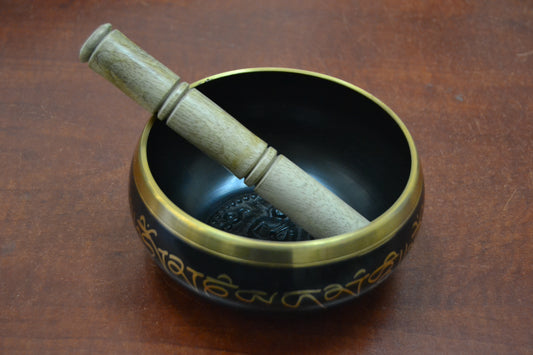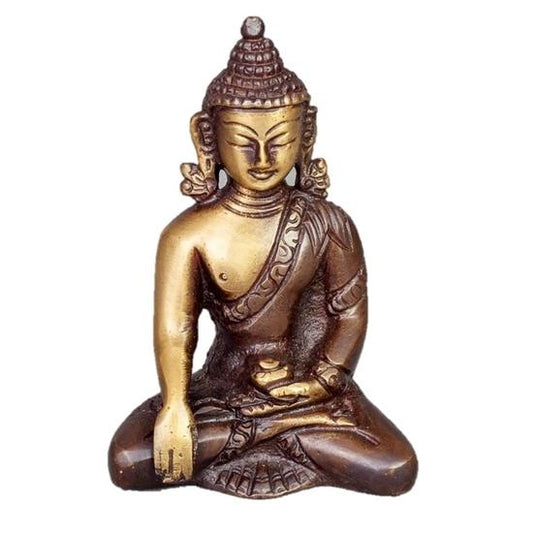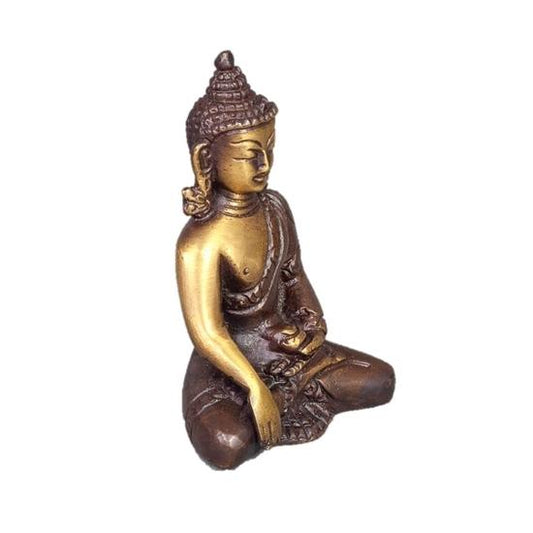Buddha Jewelry: The Enlightened Serenity - Unveiling the Mystique of Buddha Statues and the Laughing Buddha
Transforming Gloom to Joy: The Power of Laughing Buddha Statues
In the presence of Buddha statues, there is a certain aura of tranquility and enlightenment that captivates the soul. These statues, whether depicting a serene Buddha in deep meditation or a laughing Buddha with a mischievous grin, have the power to transform gloom into joy. In this blog post, we will explore the significance of Buddha statues, particularly the laughing Buddha, and how they can bring a sense of peace, joy, and positivity into our lives, enhancing our awareness and mindfulness.
The Serene Buddha: A Symbol of Peace and Enlightenment
The depiction of the serene Buddha in a state of deep meditation serves as a powerful emblem of tranquility, encapsulating the essence of peace and enlightenment. These statues are often crafted from various materials, including stone, which adds to their timeless beauty and spiritual significance. This portrayal, often seated with eyes gently closed, conveys a profound message of harmony and inner silence. The calm expression and composed posture of the serene Buddha inspire us to pursue a path of self-discovery and spiritual growth. Through this symbolic representation, we are encouraged to seek a deeper understanding of our minds and hearts, aspiring to achieve a state of Zen-like serenity in our daily lives. This image of the serene Buddha acts not just as a physical artifact but as a beacon, guiding us towards embracing mindfulness and finding solace within ourselves amidst the chaos of the outside world.
The Symbolism of Buddha Statues
Buddha statues are revered for their profound symbolism, representing the embodiment of peace, harmony, and spiritual enlightenment. Each statue, with its serene posture and gentle smile, radiates a sense of calm and tranquility, promoting inner peace and happiness. In Buddhist tradition, these statues are often adorned with intricate details, signifying the attainment of enlightenment and the path to spiritual awakening.
The presence of a Buddha statue brings a sense of harmony and balance to the surrounding environment, fostering a deeper connection with oneself and the world. The various hand positions, or mudras, depicted in Buddha statues hold significant meaning, conveying messages of protection, teaching, and meditation. Each gesture is a silent communication, guiding us towards a more mindful and enlightened existence.
The pedestal or stand on which the statue rests is also imbued with symbolic meaning, representing the foundation of spiritual growth and the pursuit of enlightenment. In many cultures, Buddha statues are considered symbols of good fortune and prosperity, believed to attract positive energy and blessings. Their presence is often used to create a peaceful and reflective atmosphere, encouraging mindfulness and meditation practices.
By incorporating Buddha statues into our spaces, we invite a sense of peace, happiness, and harmony into our lives, creating an environment that supports our spiritual and emotional well-being.
Embracing Joy with the Laughing Buddha
The Laughing Buddha, with his wide smile and carefree pose, brings an undeniable energy of happiness and good fortune into our lives. Unlike his serene counterpart, this figure is all about the celebration of abundance and the lighter side of existence. His iconic laughter, symbolizing the enjoyment of life's blessings, encourages us to approach our daily hurdles with a sense of humor and light-heartedness. This effervescent figure, often depicted carrying a sack of wealth or surrounded by children, serves as a reminder of the prosperity and joy that come with a generous and open heart. As we invite the Laughing Buddha into our spaces, we're not just decorating with an artifact; we're welcoming an ethos of optimism and laughter that can disarm negativity and foster a vibrant atmosphere of warmth and cheerfulness. This playful deity's presence in our home acts as a daily nudge to embrace the joys life offers, making every moment an opportunity to spread happiness and kindness in our surroundings.
Decorating with Jade Buddha Statues to Enhance Your Space
Incorporating Buddha statues into your decor isn’t merely about aesthetics; it’s a deliberate choice to infuse your living or working environment with a vibe that oscillates between calm and jubilance. Some of these statues can command the highest price, reflecting their intricate craftsmanship and the quality of materials used. Opting for a serene Buddha can instantly bring a wave of tranquility, turning your space into a haven where stress and turmoil feel distant. On the other hand, a laughing Buddha perched on a shelf or nestled among books can inject a burst of joy and lightheartedness into the room, subtly shifting the mood towards one of positivity and laughter. The placement of these statues is also key. In areas where moments of pause or reflection occur—like a reading nook, home office, or meditation corner—the silent companionship of a Buddha statue can enhance the quality of quietude and introspection. Conversely, positioning a laughing Buddha in more communal spaces like the living room or entryway can greet family members and guests with an uplifting ambiance, setting a tone of warmth and welcome right at the threshold. Thus, by thoughtfully selecting and positioning Buddha statues, you not only decorate your environment but also craft an atmosphere that supports your mental and emotional well-being, making every corner a testament to balance and happiness.
Creating Buddha-Inspired Art and Jewelry
Creating Buddha-inspired art and jewelry requires a deep understanding of the symbolism and significance behind the Buddha image. Artists and craftsmen must carefully consider the details and nuances of the Buddha’s depiction, ensuring that each piece accurately conveys the intended message. The use of high-quality materials, such as jade and gold, is essential in creating a piece that exudes luxury and sophistication.
One of the easiest ways to create jewelry that incorporates the buddha, is through making buddha necklaces. These often come in two forms. Some mala are simply referred to as buddha necklaces as a result of its relation to Buddhism, while others physically have either the face or a small version of the statue incorporated.
Attention to detail is crucial in crafting a Buddha-inspired piece, as every aspect of the design must work in harmony to convey the desired message. The creation of unique jewelry pieces, such as Buddha necklaces, requires a deep understanding of the symbolism and significance behind the Buddha image. By combining traditional craftsmanship with modern design elements, artists can create truly unique and captivating pieces that reflect the essence of the Buddha.
The process of creating Buddha-inspired art and jewelry is a meditative and reflective one, requiring patience, dedication, and a deep connection to the subject matter. Each piece is crafted with care and intention, resulting in a work of art that not only showcases the artist’s skill and craftsmanship but also serves as a powerful symbol of peace, harmony, and spiritual growth.
In the end, these pieces are more than just jewelry; they are expressions of the artist’s journey and a testament to the timeless wisdom and serenity embodied by the Buddha. Whether worn as a personal talisman or given as a gift, Buddha-inspired jewelry carries with it a message of peace and enlightenment, making it a cherished addition to any collection.
The Impact of Buddha Statues on Mental Well-being
Integrating Buddha statues into our surroundings has a significant influence on our psychological health. The serene imagery and symbolism embodied in these figures can play a crucial role in alleviating stress levels and enhancing our capacity for calm. When we position a Buddha statue within our view, its presence acts as a visual anchor, reminding us to slow down, breathe, and recenter our focus towards peace. This acts as a gentle yet powerful tool in managing daily stressors, allowing us to approach challenges with a clearer, more composed mindset. Similarly, the vibrant and cheerful disposition of the Laughing Buddha injects an atmosphere of optimism and resilience. It encourages a positive outlook on life, helping to lighten our burdens and elevate our mood even on trying days. The visual and emotional stimuli these statues provide contribute to a healthier mental state, facilitating a journey towards emotional stability and joy. Engaging with these symbols regularly helps foster an environment conducive to well-being, serving as silent yet impactful companions on our path to mental harmony and overall happiness.
Real-Life Stories of Transformation and Healing
The transformative impact of Buddha statues on individuals' lives extends beyond mere decoration, reaching into the realm of personal growth and healing. Stories abound of people who have experienced profound changes in their lives, attributing a significant portion of their journey to the presence of these symbolic figures. One individual recounts the role a serene Buddha played during a period of intense personal turmoil. Positioned in their meditation space, the statue served as a constant reminder of peace and mindfulness, guiding them toward a path of recovery and self-acceptance. Another narrative comes from someone who found laughter and lightness in the darkest of times, thanks to a laughing Buddha placed in their living area. This figure's joyful demeanor encouraged them to adopt a more optimistic outlook, eventually leading to a noticeable shift in their approach to life's challenges. These stories, among many others, highlight the emotional resonance and spiritual support Buddha statues can provide. They're not just inanimate objects but silent partners in the journey of life, offering solace, joy, and inspiration to those who embrace their presence. As we hear these accounts, it becomes evident that these statues are more than mere symbols; they are catalysts for healing, transformation, and a deeper connection with the essence of joy and peace in our lives.
 Sold out
Sold out




























